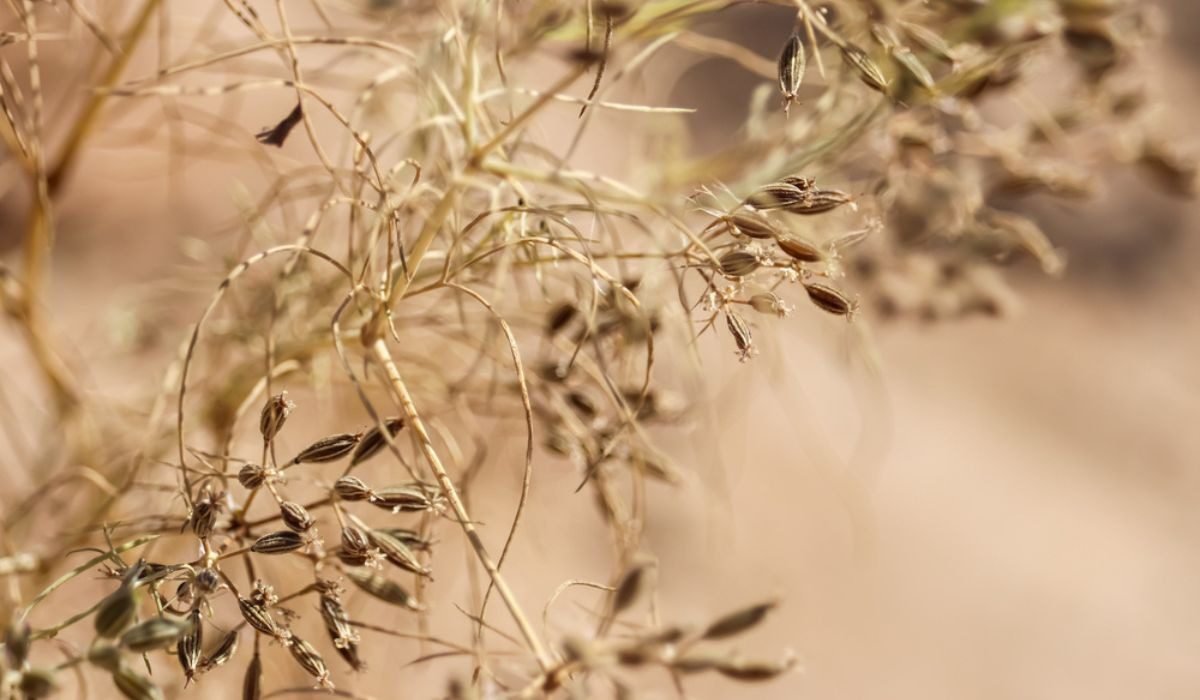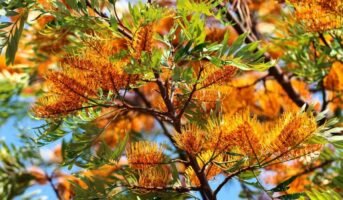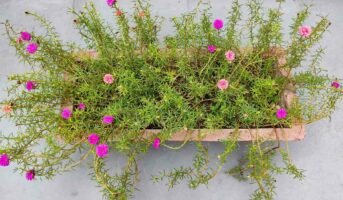Cumin (Cuminum cyminum), an annual flowering plant from the Apiaceae family, thrives in the Irano-Turanian Region and is esteemed for its aromatic seeds. Commonly used in diverse cuisines such as Indian, Asian, and Mexican, cumin’s warm and slightly bitter flavour enhances dishes like curries, chilis, and couscous. Its crescent-shaped seeds, akin to salt and pepper in some cultures, are sprinkled on prepared meals. Beyond culinary applications, cumin is pivotal in various industries, providing essential oils for international markets. This versatile herb, with delicate, thread-like foliage resembling dill and fennel, encapsulates culinary delight and industrial significance. This article will provide a comprehensive overview of the cumin plant, exploring its key facts, varieties, cultivation, care, benefits and toxicity.
See also: Gardening hacks
Cumin plant: Key facts
| Name | Cuminum cyminum |
| Common Names | Cumin |
| Plant Type | Annual, Herb |
| Family | Apiaceae |
| Origin | North Africa, Southwestern Asia |
| Soil | Well-drained |
| Temperature | Warm |
| Sunlight | Full sun |
| Height | Null to 1 Foot |
| Width | 2 to 6 Inches |
| Flowers | Small, pink or white |
| Foliage colour | Blue/Green |
| Leaves | Feathery, thread-like |
| Season Features | Summer Bloom |
| Propagation | Seed |
Characteristics
With the scientific name Cuminum cyminum, the cumin plant belongs to the parsley family and boasts a slender, branched stem reaching 20-30 cm in height. Featuring finely divided thread-like leaves, it produces small white or pink flowers that give way to oblong fruits containing aromatic seeds. With variations like Black Cumin, White Cumin, and Brown Cumin, each offering unique flavours and applications, the cumin plant is a versatile culinary herb.
Cumin plant Varieties
Cumin comes in various types, each offering a unique flavour profile:
Black Cumin
Sweet flavours, less pungent, typical in stores.
White Cumin
Strong aroma, known as the king of spices in curry.
Brown Cumin
Pungent taste, valued for digestive health.
How to grow it?
Where to Plant Cumin
Choose well-drained soil in full sun for optimal growth. Cumin requires a warm climate with temperatures 50°F to 80°F for three to four months after flowering. Avoid wet or windy conditions, and consider growing in pots if your region faces challenges.
How and when to plant Cumin
Start with sowing three to five seeds per pot indoors 4 to 6 weeks before the last frost, soaking them for 8 hours to enhance germination. Sow seeds on the soil surface at 65°F. Transfer seedlings outdoors after the last frost, ensuring they receive at least 10 hours of daily sunlight. Place cumin plants in a wind-protected location, encouraging insect pollination for optimal growth.
Care tips
Light
Plant cumin in full sun, providing at least 6 hours of direct sunlight daily. If indoors, use fluorescent lights for 14 hours a day.
Soil and water
Cumin thrives in organically rich, well-drained soil. Water regularly, especially during summer, keeping the soil moist but not waterlogged.
Temperature and humidity
Cumin requires warm temperatures and is susceptible to frost. Plant outdoors after the last spring frost when temperatures range between 50°F to 80°F.
Fertiliser
Use balanced liquid feed every 4-6 weeks, diluted to half strength. Consider a 5-10-10 blend for controlled foliage growth. Organic mulch helps regulate moisture and temperature.
Pruning and harvesting
Harvest seeds before they fall by cutting stems and storing them in paper bags. Be prompt to avoid ant infestations.
Benefits
Cumin’s significance extends beyond its culinary applications. Ground cumin is a staple in curry powder, commonly found in Indian, Vietnamese, and Thai cuisines. It adds distinctive flavours to dishes like kormas, masalas, soups, and cheeses. Traditional medicine incorporates cumin for its potential digestive and medicinal properties. Rich in essential oils, cumin aids digestion and is used in cosmetics. Its earthy, aromatic character complements stews, soups, and pickles, offering flavour and nutritional value.
Common pests and diseases
Cumin plants face minimal pest issues, attracting beneficial insects like lacewings and ladybugs that mitigate threats. Aphids and mealybugs are potential challenges, but natural predators often counteract their impact. Fungal infections such as powdery mildew, Alternaria blight, and Fusarium wilt may occur due to overwatering or high humidity. Ensuring proper air circulation and removing weeds can help prevent the spread of these infections.
Toxicity
While cumin seeds consumed as a spice or in powdered supplements are safe, caution is advised with cumin essential oil. Excessive use may lead to neurotoxic and convulsant effects, causing seizures and spasms. Phototoxic effects are possible, urging avoidance of sun exposure after crucial oil application. Dilution is recommended to prevent skin irritation or blisters. It’s essential to appreciate cumin’s culinary role while mindful of the potential toxicity associated with its concentrated forms.
FAQs
Is cumin hard to grow?
Cumin demands specific climates, preferring a long, warm season. It may struggle in extreme conditions, and careful attention is needed to prevent stunting and fungal diseases.
Can we grow cumin in pots or containers?
Yes, the compact size of the cumin plant makes it ideal for pots. Individual plants can grow in 6–inch containers and easily move indoors during adverse weather conditions.
What varieties of cumin are there?
Cumin comes in various types, including Black Cumin with a sweet flavour, White Cumin, known for its strong aroma, and Brown Cumin, valued for its digestive benefits.
What is the ideal soil for cumin?
Cumin thrives in well-drained, loamy or sandy soil with a pH between 7 and 7.5.
How do you harvest cumin seeds?
Harvest cumin seeds before they fall by cutting stems, tying them in bundles, and air-drying them in paper bags. Timely harvesting prevents destruction by ants.
What benefits does cumin offer?
Beyond its culinary uses, cumin is rich in nutrients, providing B vitamins, vitamin E, and essential minerals like iron and magnesium. Traditional medicine values it for various health benefits.
What are the common pests of cumin plants?
Aphids and mealybugs may be present, but the plant attracts beneficial insects like lacewings, ladybugs, and predator hornets that help control pest populations.
How do you prevent fungal infections in cumin plants?
To prevent fungal infections, ensure proper air circulation, remove weeds, and avoid overwatering, especially during humid conditions.
Is cumin essential oil safe?
While cumin itself is safe, caution is advised with its essential oil. High concentrations may have neurotoxic, convulsant, and phototoxic effects. Dilution and careful application are recommended.
| Got any questions or point of view on our article? We would love to hear from you. Write to our Editor-in-Chief Jhumur Ghosh at jhumur.ghosh1@housing.com |
Priya Banerjee, a writer with a keen eye on the property market, she deciphers the ever-changing trends in residential real estate. Priya excels at simplifying complex real estate terms, making them easy for everyone to understand. Her well-researched advice helps buyers and investors understand complex topics.












